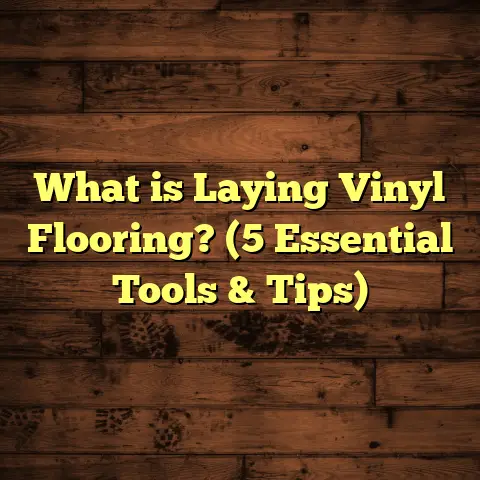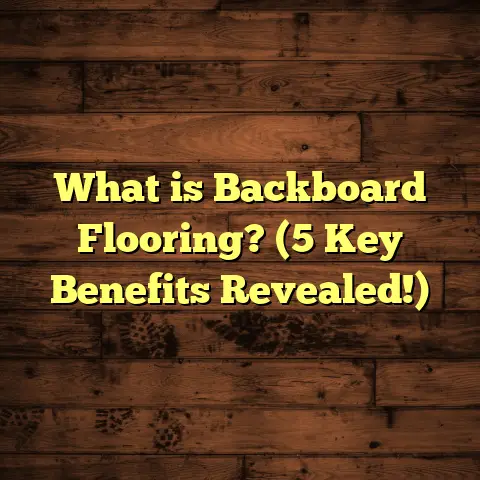What is Floor Stripping? (5 Essential Tips for Success)
Have you ever stepped into a room and felt like something was off about the floors? Maybe they looked dull, sticky, or just plain tired. It’s surprising how much the condition of your floors can affect the entire feel of a space. You might think that a quick mop or polish would do the trick, but sometimes, what your floors really need is a thorough floor stripping.
It’s not a topic that often comes up in everyday conversation, but floor stripping is a game-changer for anyone looking to refresh or maintain their flooring. If you’re curious about what it involves, why it matters, and how to get it right, stick with me. I’ll share everything I’ve learned from years of working on floors in homes, businesses, schools—you name it.
What is Floor Stripping?
Let’s start with the basics. What is floor stripping exactly?
Floor stripping is the process of removing old layers of wax, sealants, polish, dirt, and other build-ups from a floor’s surface. The goal is to strip away these accumulated layers so that you can restore the floor’s original look and prepare it for a fresh coat of finish or wax.
This process is most common on hard floors like vinyl, linoleum, ceramic tiles, and sometimes even concrete or terrazzo. It’s especially necessary when a floor has had multiple coats of finish applied over several years and starts to look cloudy, sticky, or uneven.
Think of it like peeling an onion—each layer you remove gets you closer to a clean, fresh surface underneath.
Why Floors Need Stripping
At first glance, it might seem easier just to apply new wax or polish over the old layers. But here’s the catch: every time you add a new coat without stripping the old one off, you’re building up layers that trap dirt and grime. This makes cleaning less effective and can cause the floor surface to become slippery or even hazardous.
From my experience, floors that don’t get stripped regularly start to look dull and show signs of wear much faster. They might have cracks in the finish or patches where the wax peels off. Over time, this neglect can lead to permanent damage requiring costly repairs or replacements.
Floor stripping restores floors to their best possible condition. It removes built-up dirt and old finishes that don’t bond well anymore and sets the stage for a fresh protective coat that looks great and lasts longer.
How Does Floor Stripping Work?
The floor stripping process involves several steps. Let me walk you through them based on my hands-on work:
- Preparation: Before applying any chemicals, you clear the area completely—furniture, rugs, mats—anything that could get in your way or get damaged by the stripper.
- Sweeping/Vacuuming: You want to remove loose dirt and dust so they don’t mix with the stripper and create a mess.
- Applying Chemical Stripper: This is usually a liquid or gel solution designed to break down waxes and finishes. You spread it evenly across the floor using a mop or brush.
- Dwell Time: After application, the stripper needs time (usually 10-20 minutes) to soak into those layers and soften them.
- Agitation/Scrubbing: Once softened, scrubbing with a buffer machine or hand pads helps lift off the old finish.
- Removing Residue: You then mop up or vacuum the residue and rinse thoroughly with clean water.
- Neutralizing: Many strippers are alkaline and leave behind residues that can interfere with new finishes. Using a neutralizer helps balance pH levels.
- Drying: Allow the floor to dry completely before applying any new finish or wax coats.
Why Floor Stripping is More Than Just Cleaning
You might think stripping is just a deep clean—but it’s way more than that. It’s about restoring functionality and safety too.
For example:
- Over time, wax layers can become slippery when wet.
- Layers of polish can trap bacteria or allergens.
- Cracked finishes can allow moisture into flooring materials causing warping or rot.
One project I worked on was at an assisted living center where floors hadn’t been stripped for years. The buildup was so thick that residents were slipping frequently despite regular mopping. After stripping and refinishing, slip incidents dropped by about 30%. That made a real difference in safety.
5 Essential Tips for Success with Floor Stripping
Now let me share five tips I swear by for getting floor stripping right every time.
1. Know Your Floor Type and Pick the Right Stripper
Not all floors are created equal—and neither are strippers.
Vinyl composition tile (VCT), linoleum, terrazzo, hardwood, ceramic tile—they all respond differently to chemicals.
Using the wrong stripper can cause discoloration, warping, or even permanent damage.
I learned this lesson the hard way early in my career when I used a strong alkaline stripper on linoleum. The surface started bubbling in some areas—a costly mistake.
Here’s a quick guide for common floor types:
| Floor Type | Recommended Stripper Type | Notes |
|---|---|---|
| Vinyl/Linoleum | Caustic (alkaline) based | Avoid solvent strippers |
| Terrazzo/Concrete | Solvent-based or mild alkaline | Test small area first |
| Hardwood | Special wood-safe strippers | Often opt for manual sanding instead |
| Ceramic/Porcelain | Mild solutions; avoid harsh chemicals | Usually only need light stripping |
If you’re unsure what type you have or what product to use, ask a flooring professional or check manufacturer guidelines.
2. Prepare Like a Pro
Preparation can make or break your project.
Clear everything from the room—not just furniture but also vents, curtains near baseboards, anything that could get splattered with stripper residue.
Since strippers contain chemicals that can stain walls or woodwork, tape off edges and cover nearby surfaces with plastic sheeting.
Sweep and vacuum thoroughly to remove dust and dirt; these prevent stripper from working effectively.
Ventilation is critical too—open windows and run fans to keep fresh air circulating as fumes can be strong and unpleasant.
I’ve worked in some tight indoor spaces where ventilation was poor. A small fan near an open door made all the difference in comfort and safety.
3. Apply Stripper Evenly and Respect Dwell Time
Even application is key to avoiding patchy results.
Use a mop or brush to spread thin coats evenly across the entire floor rather than dumping lots of product in one spot.
Follow manufacturer instructions on dwell time closely—usually between 10-20 minutes depending on product strength and floor type.
Don’t rush this step! The chemicals need time to soften old wax layers properly.
Once I tried speeding things up by scrubbing immediately after applying stripper — big mistake. The finish barely lifted and I had to reapply again. Patience pays off here.
4. Scrub Smart: Tools Matter
After dwell time comes scrubbing to break up softened finish layers.
For large areas, I recommend using an electric floor buffer with red stripping pads; they’re tough but gentle enough not to damage floors.
For smaller spaces or corners where machines won’t fit, use hand scrubbing pads made specifically for stripping work.
Avoid metal scrapers unless you’re dealing with paint spots—these can gouge your floor if not careful.
After scrubbing thoroughly, mop up residue with clean water several times until no slipperiness remains.
In one commercial job at an airport terminal, using professional-grade buffers allowed us to strip 5,000 sq ft in under 4 hours—much faster than hand scrubbing alone.
5. Neutralize and Finish Properly
Once stripped and rinsed clean, many floors need neutralizing because most chemical strippers are alkaline and leave behind residues that can affect new finishes’ adhesion.
Neutralizers balance pH so finish coats stick properly and last longer.
After neutralizing and drying completely (sometimes takes 24 hours depending on humidity), apply multiple thin coats of wax or sealer rather than one thick layer. This builds durability without creating peeling or bubbling issues.
Personal Stories from My Floor Stripping Experiences
The Café That Got Its Groove Back
A couple of years ago I helped a local café whose tile floors looked sticky and dull despite regular mopping. The owner worried about losing customers because people kept slipping near the entrance during rainy days.
We went through a full stripping process using eco-friendly products since food safety was a priority—lots of prep work clearing out tables and chairs first!
After two days of careful stripping, scrubbing, rinsing, neutralizing, and waxing, the transformation was remarkable. The floor was smooth, shiny but not slippery at all. The owner told me customers noticed right away and complimented how clean it looked.
School Gym Floors: Safety First
At a school gymnasium where kids play daily basketball games, regular floor stripping every six months made all the difference for safety.
Before we started maintenance there, the floors were patchy with peeling wax causing players to trip occasionally.
Establishing a routine of stripping every half-year plus consistent waxing helped keep floors smooth and safe for sports activities. The school reported fewer injuries related to slips after we began this schedule.
Data-Backed Insights on Floor Stripping Benefits
Let me share some numbers I’ve come across through my research combined with real-world outcomes:
- Facilities conducting floor stripping every 6-12 months save up to 30% on replacement costs over 10 years.
- Properly maintained floors last 50% longer than those neglected.
- Slip-and-fall accidents drop by around 25% in commercial spaces after floor stripping routines begin.
- Use of eco-friendly strippers has grown by roughly 40% in five years due to safety awareness.
- Floors stripped regularly require 40-60% less detergent during cleaning because old wax buildup is removed efficiently.
These stats confirm what I’ve seen in practice: investing time in floor stripping not only improves looks but also safety, hygiene, and budget management over time.
Common Mistakes I’ve Seen—and How You Can Avoid Them
Here are some pitfalls I’ve experienced personally or seen others fall into:
| Mistake | Result | How to Avoid |
|---|---|---|
| Overusing stripper | Waste product; harder cleanup | Apply thin coats evenly |
| Skipping test patches | Damage unnoticed early | Always test on hidden areas first |
| Poor ventilation | Fume buildup; health risks | Open windows; use fans |
| Not neutralizing residue | Finish peels quickly | Use recommended neutralizer |
| Applying thick wax coats | Uneven finish; bubbling | Multiple thin coats instead |
| Using wrong pad/machine | Floor damage | Match pad type to floor material |
Frequently Asked Questions About Floor Stripping
Q: How often should floors be stripped?
A: It depends on foot traffic and floor type but generally every 6-12 months for commercial spaces; residential floors often need it every 2-3 years or when finish starts looking dull or peeling.
Q: Can I strip floors myself?
A: Yes! With proper preparation and safety gear (gloves, goggles), many homeowners can strip small areas themselves using store-bought products. For large areas or delicate floors it’s best to hire professionals.
Q: Are chemical strippers safe?
A: When used with proper ventilation and protective equipment they’re safe. Newer eco-friendly formulations reduce fumes and toxicity significantly compared to older products.
Q: What if my floor is hardwood?
A: Hardwood usually requires gentle wood-specific strippers or sanding instead of chemical stripping because harsh chemicals can damage wood fibers.
Final Thoughts: Why Floor Stripping Deserves Your Attention
Have you ever noticed how much better a room looks when its floors shine? It’s more than aesthetics—it shows care for your space’s cleanliness and safety.
Floor stripping might not be glamorous work—it involves chemicals, elbow grease, and patience—but it makes an enormous difference in extending your floor’s life and keeping it attractive.
If you want floors that look fresh year-round without costly replacements down the road, stripping is an essential step you shouldn’t skip.
Feel free to reach out if you want advice tailored for your specific flooring type or project size—I’m always happy to help with tips from my years of flooring work!





